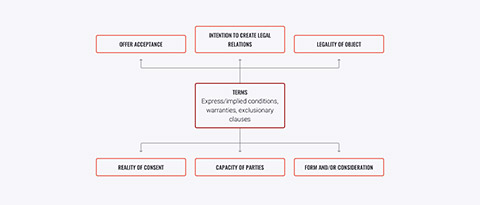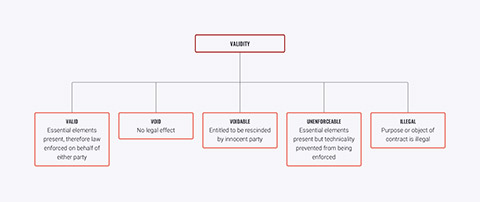Welcome to Australian Contract Law. In this topic, you will learn about:
- How to define contracts according to validity, performance and formation
- How contracts can be classified
- How to distinguish formal contracts from simple contracts
- The six essential elements required to make a valid contract (FROLIC)
- What is meant by intention to create a legal relationship and how this is determined by the law
- The distinction between an offer and an invitation to treat
- Rules with respect to offer and acceptance including the postal acceptance rule
- The meaning of ‘consideration’ and the consequence for a contract lacking consideration
- The rules regarding consideration
- How a contract lacking consideration may be enforceable if placed in a particular form
- The requirements of contracts required in writing and those required to be evidenced in writing.
Common law is the major source of Australian contract law. This means that contract law comes from the decisions of judges in court cases. This source of law is also known as case law and common law. The common law of contract is also supplemented by statutes that have been enacted by parliament. Examples include sale of goods and consumer law statutes that apply to specific transactions.
The law draws a distinction between two main types of contracts: formal and simple contracts.
- Formal contracts require the contract to be in a particular form. An example of a formal contract is a deed. This is a written document that is signed by both parties to the contract.
- Simple contracts in comparison can be in any form, written, oral or partly written and partly oral.
The important thing is that the contract has consideration. Consideration can be defined as ‘mutual promises’. One party within the contract, promises something, in return for a promise by the other party to do something. For example, I promise to sell you my car and you promise to pay me $5000.
Not all agreements are contracts however. For an agreement to be regarded as a contract under the law, six essential elements must be present. This topic examines these elements in detail. Methods by which a contract is discharged and remedies for breach of contract are also considered.
It is very important that you work through all of the essential resources in this week in the order provided as they will provide you with a comprehensive summary of Australian contract law.
Before you begin, it is advised you take the time to look at the Law Handbook from the Legal Services Commission of South Australia. This resource provides a very good summary of the principles of contract law. To navigate through the website:
- Start at the ‘Contract Law’ page on the above link.
- Select ‘next’ at the bottom of the page. That will take you to the next section. This resource includes a discussion of exclusion and penalty clauses and why these clauses are included in contracts.
- Students should read through this section up to and including ‘When a Contract Ends’.

Before you continue this topic, it is important that you spend considerable time on the Australian Contract Law website and read through relevant topics. Familiarising yourself with this website will support your understanding of the important aspects of Australian contract law.
A valid contract is an agreement made between two or more parties, giving rise to legal rights and obligations that the law will enforce. The following diagram shows the elements which need to be considered when creating or considering a contract.

Contracts can be classified into two categories:
- Validity formation
- Performance.
What does validity mean?
The following diagram describes the components of validity.

Select the headings to learn more about validity and performance.
Formation of the contract comprises of ‘express quasi’, that is, written and spoken information. The term ‘implied’ indicates the dependence on associated conduct and the final formation is by the operation of law.
There are two parts to performance:
- Executed: one party to the contract has completed its part of the contract.
- Executory: both parties have obligations to perform.
What are the essential elements of a contract?
To recap, it is important to consider the essential elements required to form a contract (FROLIC):
- Form and/or consideration
- Reality of consent
- Offer and acceptance
- Legality of object
- Intention to create a legal relationship
- Capacity of parties.
The following short video provides a very good summary of Australian contract law. The presenter gives examples of exceptions to the general rules of contract law and emphasises the nuances of contract law and the range of ways in which contracts can be made.
Format of a contract
The format of a contract is either simple or formal. Select the headings to learn more about formal and simple contracts.
A simple contract can be verbal, written and implied. Considerations must pass in both directions, and the statute of limitations is three years.
There are two parts to performance: Firstly, the formal contracts are written and do not require considerations passing in both directions, and the statute of limitation is 12 years. Secondly, formal contracts include contracts of records and contracts under seal (deeds).
With an intention to create a legal relationship, not all agreements give rise to legally enforceable obligations. People who make agreements must intend that the agreement will give rise to a legally enforceable obligation. The law makes some presumptions about this, depending on whether the agreement is of a social, domestic, or commercial nature. The following table will help you understand the difference between social/domestic and business agreements and related assumptions and proof.
| Social/domestic agreement | Business agreement | |
|---|---|---|
|
Assumption |
No intention to create legal relationship (Balfour v. Balfour) |
Intention to create legal relationship |
| Prove | Intention to create legal relationship (Todd v. Nicol Wakeling v. Ripley) | No intention to create legal relationship |
|
Presumption rebutted in contract |
When comparing an ‘invitation to treat’ and an ‘offer’, the invitation to treat is described as 'an invitation for people to make offers' (Pharmaceutical Society of Great Britain v. Boots Cash Chemists (Southern) Ltd (1952) 2 QB 795).
The person who is making it is known as an offeror and the one accepting it is known as an offeree. An offer is a proposal by the offeror that, if accepted by the offeree, will create a legally binding contract. Fun fact! Online auctions: listings on online auction sites will be regarded as offers, not invitations to treat (Smythe v Thomas (2007) NSWSC 844).
Creating a valid contract
Offer + Acceptance = Agreement
The second element required to create a valid contract is an offer, and an acceptance of the offer. An offer is a proposal, but in order to make it a legally binding agreement or a contract, the offer needs to be accepted. It is important to remember that an offer needs to be distinguished from an ‘invitation to treat.’
Rules with respect to offer
The offer is not required to be in any particular form and can be made to more than one person or group of people. When the offeror makes an offer they need to ensure all terms have been made clear to the offeree. The following video Carlill v Carbolic Smokeball case takes a lighthearted approach to explaining the concept of offer and acceptance.
In discussions surrounding acceptance and offers, termination or lapse of an offer also need to be considered. The following diagram identifies factors relevant to termination of an offer.

Let's look more closely at what is meant by a lapse, revocation and termination.
Lapse in an offer is likely to occur when:
- an acceptance is not made within the time stated
- where no time is stated, if the acceptance is not made within a reasonable time
- a counter-offer is made.
Revocation of an offer is likely to occur any time either:
- before acceptance
- if communicated to the offeree.
Termination takes place where:
- the offer is rejected
- death of the offeree or offeror may terminate an offer
- if a condition precedent of an offer is not met.
In contract law, there are rules that need to be understood when accepting and considering an offer.
Acceptance
What are the rules of acceptance?
- Acceptance must be communicated to offeror by an authorised person. An exception to this rule occurs when the offeror waives the right to receive notification of acceptance. Communication by post (postal rule) is acceptable if it is agreed that post is the method of acceptance, and the letter is stamped and addressed correctly; acceptance occurs when posted.
- Acceptance must comply with the conditions of the offer.
- Acceptance must be in reliance of knowledge of an offer.
- Acceptance must be unqualified.
- Acceptance can only be made by the offeree.
- Acceptance must take place within a prescribed time or within a reasonable time.
Consideration
For an agreement to be regarded as a contract, it must either be supported by consideration or be a formal contract. This is the third element required to form a valid contract.
What is consideration? Consideration is something that is done or promised by one party (the promisor) in exchange for something that is done or promised.
- Promisor: A promisor is a person undertaking to perform the consideration.
- Promisee: A promisee is the recipient of the consideration.
What are the rules of consideration?
- Can be present or future, but not past
- Must be of some value, but need not be adequate
- Must be definite, not vague
- Must be capable of being performed
- Must not be illegal or unlawful
- Must be more than a person is already required to do, in terms of:
- requirement by law
- compliance with contract already existing.
- Must move from the promisee
- Cannot be satisfied by part payment of a debt
- Essential in all simple contracts
Promissory Estoppel
Promissory means to ‘imply a promise’. If one party to a contract, by its behaviour, leads the other party to the contract to believe a certain state of affairs exists between them, the courts will support that state of affairs rather than the terms of the contract. Elements include:
- The promisee has altered his/her position in reliance on a new promise.
- It would be impossible for the promisee to return to his/her original position without detriment.
- It would be unfair for the promisor to renege.
There are some contracts which are required by statute to be in writing or contained in one written document. The following list states some examples of contracts which are required to be in writing:
- Bills of exchange and promissory notes
- Cheques
- Assignments and mortgages of life insurance policies
- Assignment of copyright
- Contracts for marine insurance.
Contracts that are required to be evidenced in writing include: letters passing between parties, receipt for a deposit or a cheque signed by the purchaser.
End of topic forum
There are forum activities for this topic. We all make contracts! In this learning activity, you will share the details of a contract you have made. You can share as little or as much as you like about the contract. Select the 'Forum' at the end of your module (which can be found within your navigation menu) and follow the instructions for each question pertaining to Topic 3 within the forum.
Now that you have completed the topic Australian contract law, you will find an additional resource to support your understanding of the formatting of contracts and circumstances in which they are applicable.
Interpreting Exclusion clauses – General Wording does not work.

